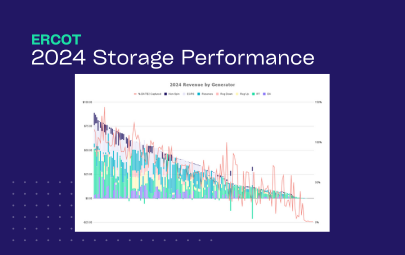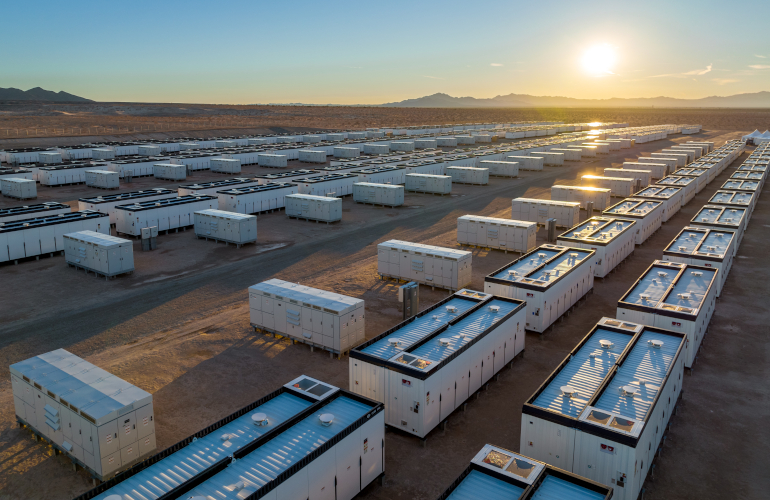Bringing a battery energy storage system (BESS) online comes with plenty of known challenges — but there are also unexpected nuances that can impact performance, compliance, and revenue. From telemetry quirks to real-world deviations in battery specifications, small oversights can add up to substantial delays and revenue missteps. Having a partner that has been through the process and can help quarterback the process goes a long way to streamline and expedite efforts.
Here are five things you might not anticipate when bringing your BESS online — and how to pre-empt them for a smoother, more successful launch.

[1] Telemetry data can be noisy
Batteries are complex systems composed of numerous individual components. It is fairly common for one of these components to have a blip, which in-turn shares data that can throw off an operating strategy. For example, faulty inverters can often result in sudden deviations in SoE readings, resulting in a “notched” telemetry behavior. Such notching can drive an optimization algorithm to oscillate between small charge / discharge actions to hit a target SoE. This kind of oscillation can reduce your revenue and increase your battery cycling over time.
We have also seen batteries can go offline completely, which results in gaps in telemetry or a full loss of data streams. If your optimizer isn’t designed to seamlessly handle these moments — by filling gaps, flagging availability issues, or reverting to safe fallback logic — you’re at risk of degraded performance or lost availability during key intervals.
An intelligent energy storage optimization software like Tyba will correct for this noise, ensuring decisions are being made based on accurate battery information, not small behavioral flaws.
[2] Timing matters
When submitting bids, timing matters – a lot. Market instruments can require submission every 5-minutes for each Security Constrained Economic Dispatch (SCED) run. Waiting until as close to the submission deadline as possible before generating new submissions allows you to take advantage of the latest market data, forecasts, and telemetry readings for optimal dispatch.
It also takes time for submissions to make it from the energy storage optimizer, through the QSE, and to the ERCOT market. Late submissions can result in bids not being submitted, suboptimal dispatch and, in extreme cases, basepoint deviations.
Prior to go-live, calculate the ideal submission time that accounts for the full process, factors in potential solve-time deviations, and ensures all parties are aligned on their roles and allowable timing. We suggest:
- Put in place clear service level agreements (SLAs) with your QSE on bid submission timelines for each SCED run
- Ensure your optimizer is aligned and can support those timelines
- During the initial phase of operations – RT-only operations – confirm timelines are being met by all parties
[3] Ramping up and down requires energy in the tank
Ramping up to discharge, or down to stop battery activity requires energy. Incorporating the precise amount of energy required to ramp into optimization models makes for the most accurate operating plan. On the flip side, failing to incorporate the energy required risks overshooting MNOS and/or MXOS limits, and even lead to basepoint deviation penalties.
For example, say you have an 100MW BESS that is selling 100MW of energy into Real-Time Energy, and it is nearing zero state of charge (SoC). You need to reserve, at a minimum, the ~2.1MWh it takes to ramp down over the 5-minute period after your discharge to avoid basepoint deviations.
[4] Battery specifications are not always exactly what it says on the box
Many of the specifications used to model battery behavior and inform the energy storage optimization won’t be exactly what they were reported to be. Prior to operations, we tend to rely on a variety of contractually or reported values. However, once an asset is operating, the observed values can be different. This is quite common for charge/discharge efficiency and auxiliary load.
For example, one battery energy storage system (BESS) we brought online had a ~4% difference between the reported and realized charge efficiency. While this may not seem like a large number, it deeply impacts the optimization.
For this reason, it is crucial to measure the realized values so the optimization is accounting for the real numbers, and evolving over time as these values change with degradation.
Our modeling team used telemetry data and ran an analysis on periods of active charge and discharge to determine the actual, realized efficiency numbers. We also rerun this analysis every day to ensure our numbers are accurate since they are critical to SOE modeling – and therefore optimization.
[5] Checklist Part 3 approval can take longer than expected
To provide Ancillary Services (AS) in ERCOT, battery energy storage systems must complete a rigorous qualification process — culminating in what’s known as Checklist Part 3 approval. While this is a known requirement, many new operators are surprised by how long it can take. The process involves a series of hardware verifications and performance demonstrations across multiple categories, including SCED participation, frequency response, and service-specific capabilities.
Here’s just a portion of what’s typically required:
- Submit one-line diagrams with CLR and interconnection (IX) hardware
- Complete PFR and SCED testing
- Demonstrate hourly capability
- Undergo Non-Spin, RRS, and ECRS qualification testing
Even after qualification, ongoing obligations like monthly performance reports, annual telemetry testing, and recertification reviews require sustained attention.
Because this process can stretch many months, we always recommend beginning Real-Time energy-only operations as soon as possible. This allows you to begin capturing revenue while working through the approval process – and ensures you are making the most of your BESS.




